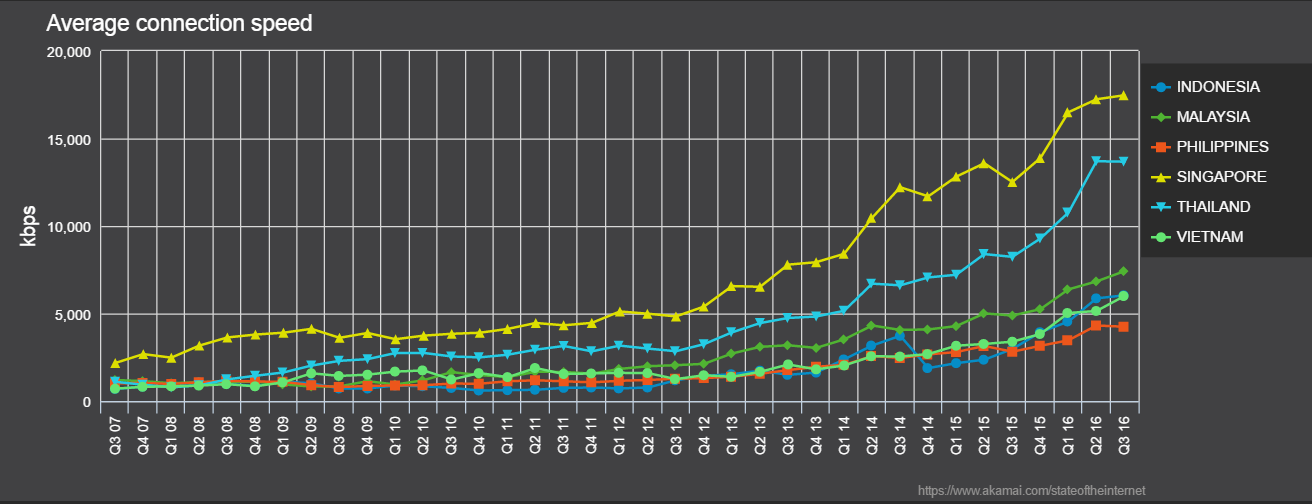
Visualization from Akamai’s State of the Internet report on connectivity for Q3 2016. / www.akamai.com/stateoftheinternet
by Mark Christofer Manalo
The Internet of Things (or IoT) has been called the next Industrial Revolution. Although this sounds like typical tech hype, various papers and studies have been published that say, yes, the Internet of Things can change the way we work and live.
The McKinsey Global Institute predicted back in 2015 that “the IoT has a total potential economic impact of $3.9 trillion to $11.1 trillion a year by 2025.” Cisco projected in a 2013 white paper that the Internet of Everything would create “$14.4 trillion in Value at Stake” for industries from 2013 to 2022. “By 2020, the number of connected devices may potentially outnumber connected people by six to one,” as the Broadband Commission predicted in 2012, adding that this would transform “our concept of the internet, and society, forever.”
All these devices, of course, would need to connect to the internet. And a slow, intermittent connection would not do. A panel at CES 2016 said that the IoT would require an “always-on, gigabit-speed internet service.”
In the latest State of the Internet Connectivity report for Q3 2016 from Akamai, the Philippines’ average connection speed was at roughly 4 megabits per second (4243.3229 kbps). Not too bad, right? I mean, I cannot even get a reliable internet connection at home, let alone 4mbps connection.
But compared to other countries, this is not good. Indonesia is at 6 Mbps, Malaysia is at 7 Mbps, and Singapore is at 17 Mbps. Compared to other ASEAN nations included in the Akamai rankings, the Philippines ranked sixth. Out of six.
From Q3 2007, the earliest available period from Akamai, to Q3 2016, the Philippines has ranked last or second to the last in 28 out of 37 quarters. Our country has ranked no better than 3rd out of the six ASEAN nations included (the other two ASEAN members in the report were Thailand and Vietnam). The most recent one was back in Q4 2008, when our average connection speed was roughly 1 Mbps. In the same quarter, Singapore had the top rank at approximately 3.8 Mbps and Thailand was second at around 1 Mbps.
Since then, our average connection speed increased 281.17% (from 1.1 Mbps to 4.2 Mbps). A huge increase, true, but this increase occurred over eight years. And, not to pile on more, but the other five ASEAN nations increased their average connection speeds by an average of nearly 600%.
Given that our internet connectivity is slow, unreliable, and expensive, would we be left out of the next industrial revolution? I have no answer for that. We were once bemoaning our lack of landline telephone penetration, but we barely even care about landlines now. Who knows what the future would bring?
But the country’s dismal internet connectivity impacts us now. Slow and intermittent internet connectivity prevents mass participation in e-commerce. It prevents workers from working remotely. (Seeing the traffic everyday coming from the north of Metro Manila, where lots of subdivisions are, suggests that a good internet connection would also help alleviate the traffic problem a bit, but I digress.) It hinders students and researchers from accessing knowledge online. And I am sure there are lots of other ways our internet connectivity (or lack thereof) affects Filipinos personally (I’ll go with item number 2).
A third internet service provider will not be coming in to break the current duopoly. Lower bureaucratic costs and delays may encourage local ISPs to invest in their infrastructure more. There are plans for a government-backed national broadband network. That will not be cheap but if any of these proposals lead to better connectivity, then great.
But I’m not holding my breath for that. Seems like traversing our information superhighway (yes, dated reference) is not much better than commuting on our actual roads.







